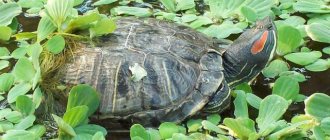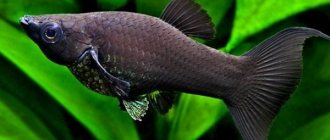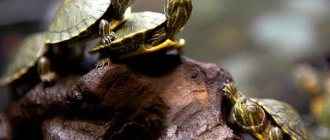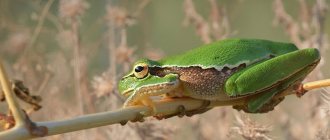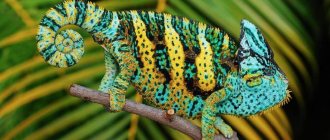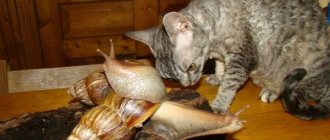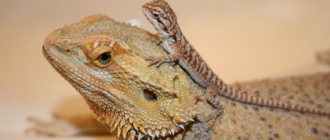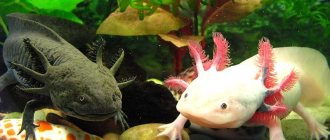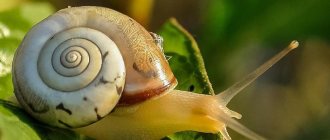General description of the animal
The toad is a frog, it belongs to the phylum Chordata, the class Amphibians, the order Tailless, the family and genus of the toad.
This amphibian was first discovered in 1761 during an expedition to the heart of Eastern Europe.
The habitat of this frog is small. It can be found in the Urals, Central and Eastern Europe. Rare, but can be found in Western Europe.
Appearance and differences from toads
The amphibian is small in size, the body rarely exceeds 5-6 cm in length. It is believed that females are larger than males. However, males are distinguished by their bright colors and aggressive behavior.
Aquarists and terrarium holders love fire toads for their non-standard color. The upper part of the frog's body is dark. With this color, it does not attract attention to itself when it sticks out of the water. However, the toad's abdomen is bright, orange with black spots with a purple tint.
Popular groups
Let's imagine a small body of water somewhere in Eastern Europe in the middle of spring. This time is perhaps the most important in the life of most Palearctic amphibians, therefore, when we come to the shore of a reservoir, we will almost certainly hear a multi-voiced concert of various amphibian jumpers. Far above the surface of the water, the solemn chorales of green frogs and the creaking and grumbling parts of brown frogs can be heard, from time to time the rather melodic trills of green toads and the businesslike “clatter” of spadefoot frogs can be heard, and sometimes a sharp and abrupt part of a tree frog will suddenly be heard. In all this polyphony, you will not immediately hear quiet, minor inserts, reminiscent of either groans or sobs. Let's try to find the one who publishes them. It is not so easy to see, but if we look closely, we will soon notice on the surface of the water a small, no more than five centimeters, brownish or olive amphibian, similar to a miniature toad. Swaying on the surface of the water and strongly inflating the throat sac, the little singer makes those very sad sounds. This toad is one of three species of this genus found in Europe. Three (according to other sources - five) other types of fire-bellied toads are common in the Russian Far East and East Asia (China, Korea and Northern Vietnam).
Fire-bellied toads (genus Bombina) are one of the oldest tailless amphibians; frogs very similar to them existed 180 million years ago. The antiquity of these amphibians is indicated by some primitive features in the structure of the skeleton (for example, the presence of ribs - other anurans do not have them). The family they belong to is called disc-linguals. The name of the family indicates that the tongue of fire-bellied firebirds, unlike the tongue of most anurans, has a rounded shape and is not capable of shooting out of the mouth, capturing prey at a distance. Externally, toads resemble small toads - they have the same warty skin and a somewhat overweight build. All species have bright yellow, orange or red markings on their bellies. The back is usually olive, brown, green or brownish. Another characteristic feature is the pupils of an unusual triangular shape. The length of domestic species, as a rule, does not exceed 4-6 cm. Their habitat also testifies to the ancient origin of toads. Such intermittent distribution is called disjunctive (from the Latin word disjunctio - disunity) and in the case of fire-bellied firebirds indicates that in earlier times the range of these amphibians was most likely continuous, from Western Europe to East Asia. But during the last glaciation, when cold winds blew from the north and glaciers reached out, the serene existence of the ancient fire-bellied firebirds (and most other animals) ended, and in most of their range they became extinct, unable to withstand the harsh snowless winters of the Ice Age. In Europe, fire toads were then preserved only in small refugia (shelters) in Italy, on the Balkan Peninsula and in the northern Carpathians. It is from these “exiles” that modern fire-bellied toads originate, which, after the end of the Ice Age, again settled throughout Western and Eastern Europe. In East Asia, glaciation was local in nature, which contributed to the preservation of many representatives of the ancient, pre-glacial fauna, including fire toads.
European toads were already well known to the founder of zoological taxonomy, Carl Linnaeus, who, however, attributed them to the genus Rana (real frogs). Only half a century later, in 1816, the German naturalist Lorenz Oken revised the taxonomy of toads and separated them into the independent genus Bombina (“buzzing”), in which they remain to this day.
Researchers' attention to the toads did not end there - it was noticed that the skin of the disturbed toad begins to secrete a special secretion, which irritates the mucous membranes of the eyes, nasal and oral cavities, and has a detrimental effect on amphibians comparable to the toads. This secret is called “frinolysin” - it helps fire-bellied toads to protect themselves when all other means of defense have been exhausted.
Let's touch on these funds in more detail. Imagine that you managed to catch a fire-bellied toad by surprise on the shore and cut off its path into the water. You are already about to grab this seemingly completely harmless amphibian, but it freezes in place and suddenly arches its body in a special way (as if trying to make a “bridge” while lying on its stomach), takes it to the sides and turns its fore and hind limbs in a special way, and what do we see? The abdomen and inner surface of the toad's limbs have a bright red, yellow or orange color and look quite unusual, especially to an enemy who has just seen a nondescript amphibian in front of him. For many who want to feast on the fire-bellied toad, such a sudden demonstration of brightly colored areas of the body, which are usually hardly noticeable, has the desired effect, and they retreat. Particularly hungry and persistent people decide to grab the toad and receive a portion of frynolysin. It is worth mentioning that similar protective behavior with the demonstration of brightly colored areas is also inherent in some other amphibians (from the tailed ones - Salamandrina, Taricha, Tylototriton, and from the tailless ones - toads of the genus Melanophryniscus), also equipped with bright warning spots on the ventral side of the body. “In honor” of the toaded toads, this technique was called “unkenreflex” (German: Unkenreflex - “toaded toad reflex”).
Despite the fact that fire toads have few enemies, their numbers in nature are usually low. This is due to the fact that female fire-bellied fire-bellied eggs lay a relatively small number of eggs (up to 300 in the red-bellied fire-bellied fire-bellied toad, up to 100 in the Far Eastern fire-bellied fire-bellied toad), and young fire-bellied fire-bellied eggs die in large numbers during the period of reaching land and the first wintering.
The toad genus includes, according to various estimates, from 5 to 7 species, three of which live in Europe. Better than others, domestic naturalists know the red-bellied firebird (Bombina bombina), which is widespread in the European part of Russia, and outside our country - in Central and Eastern Europe. In the west, its range reaches Germany, Slovakia and the Balkans.
The back color of this species is grayish-brown, with dark spots. The largest elongated spots are located on the shoulder blades and sacrum. The belly is black, with red spots and white dots scattered on it.
The red-bellied toad is predominantly a forest species; it prefers to settle in small bodies of water - ponds, puddles, ditches, and river creeks. Does not like open places; it chooses water bodies with abundant aquatic and coastal vegetation for habitat. During the period of activity, it leads a mainly aquatic lifestyle. Occasionally, toads crawl out onto the shore or leaves of floating plants. They feed mainly on aquatic insects, as well as butterflies, ants, and beetles that accidentally fall into the water. As a rule, they do not hunt underwater and dive only in case of danger. They reproduce, like most of our amphibians, in the spring. The male fire-bellied toad, calling for a female, emits a characteristic moaning cry, inflating internal resonators - formations unique among fire-bellied toads, absent in other species of the genus. When mating, the female lays up to 300 eggs, attaching them one at a time to aquatic plants. Tadpoles are omnivores: they catch small crustaceans, rotifers, and scrape off algae. For wintering, red-bellied fire-bellied toads usually come to land.
The closest relatives of the red-bellied toad are the yellow-bellied toad (B. variegata) and the Apennine toad (B. pachypus), the latter sometimes being considered a subspecies of the yellow-bellied toad. They differ from B. bombina mainly in the distribution and color of the bright spots on the abdomen. Hybrids are sometimes found in the contact zones of habitats. The yellow-bellied firebird inhabits Europe to the west of the red-bellied firebird's distribution range, reaching as far as the Pyrenees mountains. In the CIS it can be found in the Carpathians and Transcarpathia. It lives mainly in mountainous regions, inhabiting a variety of small bodies of water in a large number of different biotopes: mixed and deciduous forests, meadows, floodplains. Unlike the red-bellied toad, it prefers temporary rather than permanent bodies of water. As a rule, it is a common species with a fairly high and stable population. Due to its high ecological plasticity, this toad takes root relatively easily in anthropogenic biotopes; it can even tolerate some salinity of water, which is destructive for most other amphibians. Its lifestyle resembles the previous species, but spends slightly more time in water and less time on land.
Among the Asian species, one species, the Far Eastern toad (Bombina orientalis), is closely related to the red-bellied and yellow-bellied toad. The Far Eastern toad is common in Korea, China and the Russian Far East. Notable is the rather bright color of its back - light green, bronze or brown, sometimes with black spots. The abdomen is smooth, unlike European fire-bellied toads, in which it is covered with small tubercles, and the color of the spots on it varies from yellow-orange to bright red. Red and black colors occupy approximately equal area on the belly. There are two known ecological forms of the Far Eastern toad – forest and meadow. The forest form reaches 5 cm in length and is found mainly in cedar-broad-leaved and other forests, bush thickets in valleys and floodplains. It breeds in small, well-warmed stagnant bodies of water: lakes, ponds, ditches, puddles. Females lay up to 200 eggs per season, one at a time or in small portions. Outside the breeding season, the Far Eastern forest toad comes to land. The meadow form is smaller and leads a mainly aquatic lifestyle, like the European toad. It is found only in forb and sedge-reed meadows of the Khasan Plain.
There is data on both artificial and natural hybridization between different fire toad species. In nature, a hybrid zone exists between the ranges of B. variegata and B. bombina. Its width, however, nowhere exceeds several kilometers: large-scale crossing of the two species is hampered by the low viability and fertility of the hybrids. Data from laboratory crosses showed that males of hybrids of the first
generations in this case are completely sterile, although females retain fertility. This preferential loss of fertility and viability by one sex of hybrids is very common in nature and is called Haldane's rule. It is believed that this phenomenon is associated with differences in the structure of the Y chromosomes of different species. The offspring of both sexes from crossing hybrid females with both pure parental species are sterile.
When artificially crossing the yellow-bellied toad with the Far Eastern one, according to the observations of V.K. Uteshev, a similar situation is observed. Japanese researchers, however, obtained a different result: at the very first crossing of the Far Eastern and yellow-bellied toads, they obtained completely sterile hybrids.
The remaining species of toaded toad (Bombina lichuanensis) and large toaded toad (Bombina maxima), as well as the Hubei toaded toad (Bombina microdeladigitora) distinguished by a number of specialists, distributed in China, Vietnam and Myanmar, represent another branch of the evolution of the genus. As a rule, these are large, up to 8 cm, massive amphibians with pronounced parotids (oblong glands on the sides of the head). The color of the back of the large toad is yellowish or light brown, sometimes with green, the belly is black with bright spots, like in European species. The ecology of these toads is very peculiar and differs significantly from that of the above-mentioned representatives of the genus. They lead a predominantly terrestrial lifestyle, living in the rubble of bamboo trunks, and for reproduction they use cavities filled with water in these trunks. These toads became known to researchers relatively late, and their evolution, distribution and way of life are not fully understood.
Fire toads are very popular among terrarium keepers due to their availability, beautiful coloring, and ease of maintenance and breeding. Already in the 19th century, they were mentioned in aquarium manuals as amphibians that were quite suitable for keeping in aquaterrariums. In particular, the luminary of the Russian aquarium hobby Nikolai Fedorovich Zolotnitsky mentions their contents, and the classic of Russian literature Anton Pavlovich Chekhov mentions fire toads among other animals sold at the famous Pipe Market in Moscow: “The most interesting thing is the fish department. Shower, ten men sit in a row. In front of each of them there is a bucket, and in the buckets there is a small pitch hell. There, in the greenish, muddy water, crucians, bindweeds, little ones, snails, fire-bellied frogs, and newts swarm...”
Since then, keeping fire-bellied toads has been well mastered by both foreign and domestic hobbyists. The latter, in particular, until recently, had virtually no access to exotic amphibians and reptiles, so the main attention was paid to species living in the territory of the former USSR, including our today's heroes. The toaded toads were also given the attention of such venerable popularizers of aquatic and terrarium science as Mark Davydovich Makhlin and Viktor Gavrilovich Gusev, who devoted many lines to these miniature, brightly colored amphibians in their excellent books.
Toads can be kept both in aquaterrariums and in ordinary aquariums with a small raft. If desired, the storage spaces can be landscaped, giving them a more natural look.
Various modifications of the aquarium or aquaterrarium for fire toads are possible. The area, especially when keeping a group of animals, can be increased, but a depth of about 5 cm is sufficient. As mentioned above, fire-bellied toads almost never dive. The land, if desired, can be designed not in the form of a foam island, but in the form of a full-fledged shore with driftwood and various decorations.
There are no particular difficulties in feeding fire toads. They readily consume young marbled cockroaches, crickets, bloodworms, earthworms, tubifex lumps and other popular types of live food. In the summer you can give them insects from nature - caterpillars, small grasshoppers. It is advisable to feed with tweezers, or by placing the food in a bowl on the shore. Toaded toads will not collect food from the bottom of the aquarium and will not eat artificial dry food.
In captivity, toads behave quite actively for amphibians, swim, hunt, and constantly move from water to land and back. When the aquaterrarium is opened, animals accustomed to feeding with tweezers show obvious interest and swim up to the owner in anticipation of food. When excited, they may grab empty tweezers or fingers, and sometimes even jump out of the aquarium.
The authors have separate experience in keeping two types of toads. A. Ostroshabov successfully kept and propagated Far Eastern, and A. Lisachev - yellow-bellied fire-bellied firebirds. The following is the experience of each of the authors:
A. Ostroshabov: “In the case of fire toads, for the first time I personally encountered such an annoying fact as the inaccessibility of the domestic herpetofauna in comparison with a variety of exotic amphibians and reptiles. It is often easier to own a decorated slingshot or pearl lizard than, for example, a Mongolian toad or Amur longtail. All the more pleasant it was in the late autumn of 2004 to discover three Far Eastern fire-bellied toads in one of the pet stores in Barnaul, which I immediately purchased. Subsequently, it turned out that these toads were bred and raised by the famous Barnaul terrariumist D. Zvorygin, from whom I received a few more pieces after some time. All the toads were planted in an aquaterrarium, converted from an old aquarium with a volume of 40 liters. I covered the bottom with coarse river sand and, using pebbles, built several terraces on it, which later became banks. The layer of water in this improvised aquaterrarium was only about 4-5 cm. Of the plants in such a “puddle”, only riccia and hornwort could grow, and even those had to be replaced regularly - actively moving between the shore and the reservoir, sooner or later the toads pulled the plants ashore , where they were quickly trampled down. My toads fed on bloodworms, tubifex and earthworms, which I bought at a fishing store.
Since the aquaterrarium with fire toads stood on the windowsill, I did not use any additional lighting, which subsequently led to somewhat unexpected (for me) results.
Around the end of February, male fire-bellied toads began active vocalization, every now and then trying to embrace females (the mating embrace of amphibians is called amplexus) and constantly sorting things out among themselves. It looked like this - while in the water, two males were positioned opposite each other and, grabbing hold of their front paws, tried to drag each other to the bottom. Despite such activity, I did not expect any offspring, since I was sure that for this, Palearctic amphibians and reptiles need wintering. Imagine my surprise when one day, in mid-March, while removing another batch of hornwort broken by toads from the aquaterrarium, I discovered an already grown tadpole in the water! Upon careful examination, about a dozen more of its fellows were found, as well as developing eggs. The main role in this spontaneous reproduction was, of course, played by the change in the length of daylight hours, which the toaded toads, being at the window, felt to the fullest. The eggs and tadpoles were placed in a separate aquarium, and spawning, meanwhile, continued until the beginning of April. Eggs were laid in portions of one to five pieces at intervals of up to several days; their development at a temperature of 20°C lasted 3-4 days. I fed the tadpoles with boiled potatoes, scalded dried nettle leaves (sold in pharmacies) and flake food for aquarium fish. The water in the aquarium was constantly weakly aerated; 50% of the volume was replaced weekly. Development at a temperature of 18-22°C took 45-50 days, at the final stage the young with a shortened tail and fully formed limbs were transferred to an aquarium with a thin, half-centimeter layer of water and large islands of riccia. In general, leaving fire-bellied toads (and many other amphibians) that have completed their metamorphosis in an aquarium is fraught with disastrous consequences - the newly formed amphibians still (or no longer) can swim, and without access to land they easily drown even with a small layer of water. The food for young Far Eastern fire-bellied toads was tubifex and small larvae of Turkestan cockroaches (Shelfordella tartara) with the addition of vitamins "Reptilin" and calcium supplements "Reptocal", then, when they grew up and were placed with their parents, I began to offer them marbled cockroaches, bloodworms and insects mowed down in nature. The latter, by the way, is a very desirable food for most insectivorous terrarium animals, and thanks to it, the toads retain the bright color of their abdomen.”
A. Lisachev: “I started keeping fire-bellied firebirds in 2007, having bought a male B. orientalis at the Novosibirsk Bird Market.. It was largely a spontaneous purchase, but I was already familiar with the biology of fire-bellied firebirds and the general principles of their maintenance. literature. I used a small aquarium measuring 30x25x20 cm, filled it with water and threw a foam raft into it. Over the next few days, the design of a new home for the toad was completed: soil and plants were purchased, and pieces of bark were placed on the raft. The final version was as follows: the water level was 15 cm, a layer of aquarium gravel was 2 cm, the entire volume was filled with floating plants such as hornwort. The raft, measuring 10x15 cm, was covered with a layer of Java moss (we had to get rid of pieces of bark, as the toad constantly knocked them into the water). There were no aeration or water filtration systems; water purity was maintained through regular changes. With each change, all the dirt was collected from the thickness and surface of the soil. According to my observations, the Far Eastern toad spends approximately the same amount of time in water and on land.
The year before last, I was able to continue my acquaintance with this interesting genus of frogs: yellow-bellied toads were brought to one of the city’s pet stores. This time I took not just one individual, but a pair, hoping to get offspring. New residents were moved into the same aquarium described above. I didn’t notice any conflicts between them and the old-timer; toads of different types got along well together.
After the animals got used to the new place and had eaten, mating calls began to be regularly heard from the aquarium, and both males were screaming. Particularly intense vocalization was observed after feeding or water changes. At this point, I removed the male Fire Toad to avoid accidental hybridization. Yellow-bellied firebirds were additionally stimulated with injections of gonadotropin - 100 units for males and 200 units for females. The next morning after stimulation, I removed 75 eggs from the aquarium.
The eggs were placed in a small 300 ml bowl to make it more convenient to observe their development. Within three to four days, the tadpoles began to hatch. The length of the tadpoles was 1-1.2 cm. Afterwards, some of the tadpoles were given to the youth station for rearing, and some were placed in a 35-liter aquarium planted with Cryptocoryne. Floating plants such as
hornwort.
The recommended volume of water for one tadpole is 1 liter. The tadpoles were given TetraMin aquarium fish food in the form of flakes as food. The water was changed every three days. Metamorphosis occurred within 2 to 3 months after hatching, with a body length with a tail of about 4 cm. Fingerlings do not drown and can be kept in an aquaterrarium from the very beginning.”
To summarize, we can say that toads are one of the best solutions for a novice hobbyist interested in tailless amphibians. Compared to clawed frogs and hymenochirus, which are popular among beginners, fire-bellied frogs lead a more interesting and varied lifestyle and are more beautifully colored, and are approximately equal in complexity of keeping them. It’s not for nothing that fire toads remain one of the most favorite frogs even among experienced terrarium keepers.
A. Lisachev, A. Ostroshabov.
Varieties
Scientists know several types of toads, which vary depending on their behavior, color, and place of residence.
Far Eastern Fire Toad
This species lives in the Far East and can also be found in Korea and the People's Republic of China. If you look at the coloring of this toad, you will notice that it is similar to its red-bellied sister. However, the belly of the Far Eastern frog has a bright orange hue, and the spots are not so large.
The animal is predominantly nocturnal. Feeds on insects. It chooses marshy areas to live.
The belly of the Far Eastern frog has a bright orange hue.
Yellow-bellied Firebird
This resident of the Carpathians is also often found in Central Europe. And some evidence suggests that it is found on the eastern shores of European bodies of water. Prefers to settle on hills, the height of which is 500 m above sea level.
Differs in appearance from its sisters. Its abdomen has a bright yellow tint, and the spots on it are small, barely visible.
The yellow-bellied firebird prefers to live at higher elevations
Character and lifestyle
The toaded toad is valued for its ability to adapt to any conditions and has a pliable nature. It is believed that it can live both in water and in soil. She is more active when evening falls and twilight begins.
It loves warmth, prefers moisture, but dryness and cold can destroy toads.
During the period when the temperature rises above 28 degrees, they can stay awake all night.
Frogs love to be on the surface of the water, spread out on it. It is rare to see them swimming on the surface on their own. The frog gets its own food. To do this, in the wild it can swim up to 800 m.
In an aquarium or terrarium, the frog has a much easier time.
If you look closely, you can see small glands on top of the toad’s body that protrude through the skin. They are necessary to produce frinolicin. This is a poisonous substance that can protect the frog and scare away enemies from it.
The toad's body has glands that produce a toxic substance.
However, a person should not be afraid. For him, this poison is harmless, but it is still undesirable for it to get on the mucous membranes of the body. Otherwise, it may cause an allergic reaction, burning and pain.
Experts recommend separating the toad from snakes, newts, and other frogs from the red-bellied beauty. A small amount of poison is enough to kill a newt. This substance will also be dangerous for pets, such as cats, dogs or mice.
It is believed that the average life expectancy of a toad in the wild is 10 years. However, such frogs quickly become food for other amphibians or large animals. In a terrarium or aquarium, where all the necessary conditions are met, the toad can live up to 20 years.
In the wild, toaded toads live up to 10 years, in a terrarium up to 20 years
Toads
In our country, common toads are the gray toad (gray-brown on top and yellowish below), the green toad (its lumpy skin is grayish-olive in tone with green spots), the reed toad (less lumpy, with a light stripe along the back) and the similar Mongolian toad .
There are many poisonous glands on the skin of toads, among them two large suprascapular (behind the eyes) glands, which can “shoot” poisonous secretions at a distance of up to 1 m. Small glands are located on the head, body and legs. They are the first to fire at the moment of danger, releasing an odorous secretion with a bitter taste, causing a burning sensation and vomiting in the attacking predator.
A positive point: toads are nocturnal animals and only occasionally crawl out of secluded corners during the day.
What do they eat?
Properly selected nutrition is the key to frog health. In the wild, they can also eat invertebrates, including dragonflies, worms or beetles. The menu depends on where the frog lives. In the wild, she is forced to eat what is nearby. There are frequent cases of cannibalism, when large individuals eat small ones. To prevent this from happening, do not forget to give your charges food in a timely manner.
In the wild, a frog can feed on duckweed, fish, insects, and river vegetation.
Aquarium inhabitants are selective in food.
You can offer them:
- bloodworm;
- tubifex;
- daphnia;
- cricket;
- mealworm.
Aquarium toads are selective in food; you can offer them bloodworms
To make the diet varied and balanced, it is recommended to alternate it with store-bought food.
You need to choose one that is designed for amphibians of this type.
Don't forget to add mineral or vitamin supplements to your food occasionally. This should be done in spring and autumn.
Alariasis
– helminthiasis, the causative agent of which is the trematode Alaria alata, which parasitizes the stomach and intestines of animals. Additional hosts for these worms are frogs and tadpoles. If a cat catches and eats a frog or tadpole infected with alaria larvae, it will become ill with alariasis.
What to do? As always, worm your pet regularly!
So, if your ward is walking in nature:
- you should find out whether there are toads, toads or spadefoots in your area (to know the enemy by sight)
- if you notice a lot of foam from the mouth of your pet or other signs indicating contact with a poisonous frog or toad, you need to rinse his mouth and, if necessary, take him to the clinic;
- Don’t forget to give anti-worm medications on time(!)
Source: CatiCat.ru
Where do they live?
More often the toad can be found in Germany, Austria, Eastern Europe and even in the Urals. Representatives of this species are found in the northwestern part of Denmark and Sweden.
But high temperatures also do not scare away the frog, so it can easily be found in the Krasnodar Territory, Stavropol Territory and even in Turkey.
For life, the fire toad chooses shallow reservoirs, ditches, rivers and streams, where there is abundant shade.
It is important that the current be slow or the water be stagnant. Toaded toads love warm bodies of water, so they choose those that are well warmed by the sun's rays.
Toaded toads love warm waters
The area prefers to be predominantly swampy, with small rivers and canals.
Less commonly, the toad can be found in creeks, but this is the exception rather than the norm.
Toaded toads prefer to spend time in water, so they cool their skin. However, there are periods when they come to land.
Little toads, unlike many other species of frogs, have developed lungs. This allows them to take in large amounts of air and stay under water for a long time.
Habitats
The red-bellied firebird inhabits the southern part of Sweden, Denmark, northern Germany, Poland, Czechoslovakia, Hungary, Romania, Bulgaria, and northeastern Turkey. In the territory of the former USSR it is found between 45° and 56° N, reaching Chelyabinsk, Tyumen and the Ural River in the east. Absent in Transcaucasia.
These amphibians prefer to live in lowlands and plains in forest, forest-steppe and steppe zones. Most often they can be found in lakes, ponds, floodplains, stream channels, springs, wells, and puddles. They also live in reservoirs completely overgrown with reeds, rush grass and other semi-aquatic vegetation. They avoid strong currents.
The water in reservoirs occupied by the red-bellied firebird is usually cleaner than in reservoirs where its yellow-bellied relative is found.
Reproduction and lifespan
Frogs have a long life expectancy. In the wild, on average, it is 10 years, but at home - all 20.
Sexual maturity in this species occurs after 3-4 years of life. Such an amphibian is already ready for the mating season. Fire toads reproduce mainly in the summer. The mating season of toaded firebirds is characterized by special behavior of individuals.
Males begin to actively compete for the attention of females. To become the boss, they try to attract attention in an unusual way: they begin to knock their paws on the surface of the pond, snags, and dry land. It is important for them to raise as much spray as possible to the top. The one who succeeds demonstrates his “strength” to other males.
During the mating season, males begin to actively compete for the attention of females.
If we talk about females, they choose a partner for mating based on size. The larger the male, the more attractive he is.
Females are fertile: they can lay about 300 eggs in one clutch. The eggs are placed mainly in plants near the shore or algae.
The incubation period for eggs is up to 10 days. Then tadpoles appear, no larger than 5 mm in size. They move quickly and can cover impressive distances in search of food. Tadpoles have wide fins, so they have no difficulty moving.
After a few weeks, the tadpoles' tail disappears and they become like an ordinary frog. They begin to eat fully and look like an adult at the age of 3 months.
Many tadpoles do not live to this age. The reason is the lack of parental instinct in frogs. Many males and females eat the offspring.
After a few weeks, the tadpoles begin to look like a regular frog.
Development
Tadpoles 45 mm long emerge from the eggs (a mesh structure is visible on the caudal fin). In the first days, the larvae feed on the yolk sac. Tadpoles spend the first week of life attached to plants or rocks with their mouth openings. Fire toad larvae are predators. They eat algae (detritus, blue-green algae, etc.), corpses, mushrooms, higher plants and protozoa. Complete metamorphosis occurs in 2-2.5 months. During metamorphosis, nutrition stops for a short time. Late hatched tadpoles overwinter in water bodies.
Natural enemies
Thanks to its poisonousness, the frog can boast that it defends itself from predators. A fairly large number of animals hunt for fire toads.
Among the reptiles are marsh turtles, grass snakes, and vipers. Newts, herons, storks, ducks, and rodents are not averse to feasting on frogs. The bright color of the abdomen makes it possible to scare away enemies, and those who are not afraid to come closer may receive burns or die from poison.
Wintering
The frog prefers high temperatures. But when it starts to get colder in the natural environment, animals can hibernate. As a rule, this happens in late October-early November, when frosts become common.
The frogs begin to look for a place to hide. They hide in sandy holes, under snags, in abandoned holes. If they live close to places where people live, they can settle under buildings. They can often be found in basements or cellars.
Hibernation in fire-bellied toads lasts from 50 to 60 days. Frogs wake up when the weather gets warm. They need two weeks to come to their senses and fully restore their strength. And then comes the mating season.
Toads can hide in sandy holes for the winter.
Toadstool poison
The toaded toad is an amphibian that can be called cautious. Thanks to this quality, she survived in the wild with such a small size. If she feels that she is in danger, she tries to hide: she goes under water, climbs into holes or buries herself in silt.
But if it is impossible to hide, the frog’s skin begins to quickly produce special mucus, which is created in individual glands.
This poison is not dangerous for humans, but if for some reason it suddenly gets on the mucous membrane, a burning sensation and lacrimation may occur. Then it is necessary to rinse the affected areas with running water.
The poison is dangerous for animals. If any of them interact with the surface of the toad's body, then everything can end in disaster, and death is possible.
The toad's poison is not dangerous for humans
Features of keeping at home
To make the frog comfortable at home, you need to choose an aquarium for it. A tank with impressive dimensions will become a comfortable home. It is important that it is selected according to the size of the individual. It is recommended to place the tank in a place where there is bright lighting.
But it is better to avoid the kitchen and places where aerosols are sprayed. The toaded toad is sensitive to foreign odors.
It is necessary to create the correct conditions for temperature and light inside the aquarium where the toaded toad lives.
The optimal length of daylight hours for her is 12 hours. Temperature range – from 28 degrees Celsius and above. If the house is much cooler, you can put a thermal mat.
Don't forget about the soil. It fills the bottom of the tank. Fine gravel or large pebbles work well.
Gravel is an ideal soil for a toaded toad aquarium.
You can also place various shards from jugs, bamboo stems, and artificial decorative elements in the terrarium. You can paint the tank with plastic plants, as well as other decorative elements, among which it will be interesting for the frog to move around.
If the frog is placed in an aquarium, the water in it must be cleaned once a week, changing about a quarter of the volume.
Do not forget about the need to install a special filter. The frog is sensitive to cleanliness, so it is necessary to clean the tank as often as possible.
Diseases and their prevention
The toaded firebird, like any other amphibian, is susceptible to some diseases. Owners should be aware of these nuances before getting such a pet.
- Oral abrasions. Frogs are not very careful, so they develop various injuries in the mouth area. In order to quickly heal the wound and not get severe inflammation, antibiotic therapy is required. Frogs make compresses or rub in ointment. It is important to isolate this individual from other representatives of the aquarium or terrarium so that it has time to fully heal.
Frogs are not careful, so they may develop damage in the mouth area
- Helminthic lesion. More often this happens as a result of poor quality nutrition or dirty water. It can be cured with the help of special powders that are added to food.
There are other diseases that can affect the toad. But much less frequently than those listed above.
What to do?
First aid consists of abundant rinsing of the mouth, for example, with a stream from a hose (or syringe). At the same time, the cat's head should be lowered down so that water does not get into the throat, and she cannot swallow it. Then, if possible, wipe the cat's teeth with a damp cloth and give her activated charcoal.
Since amphibian venom is highly toxic to animals (even fatal), your pet should be examined by a veterinarian.
But eating frogs, not necessarily poisonous ones, carries another danger.
Red-bellied frog in the Red Book
Not many people realize that the red-bellied firebird is a representative of the Red Book of Russia and Latvia. And there are a number of reasons for this.
Main causes of extinction
The frog does not die from natural causes. Human activity provokes the fact that fire toads have nowhere to live. Due to the drainage of water bodies, the frog population decreases by 10 or even 13 times.
The red-bellied firebird is a representative of the Red Book of Russia and Latvia
Today, appropriate measures have been taken so that amphibians can survive. New reservoirs are being created to regulate the number of amphibians.
The Berne Convention protects wild fauna, including this species. The document prohibits the catching of red-bellied fish and species, and water bodies are carefully protected from pollution and other species and human influence.
Current population situation
Today, the frog population is gradually increasing, but this does not mean that you need to relax. It is important to understand that such frogs are in great need of attention from people.
Therefore, today measures are being developed that will increase the population.
Interesting facts about the animal
Fire toads have many interesting features:
- The toaded toad, unlike other frogs, cannot quickly stick out its tongue and grab food with it.
- Each frog has a unique pattern that is not repeated in other individuals.
- The toaded toad cannot croak precisely because of the peculiar structure of its tongue. That's why she makes interesting and funny sounds.
- Frogs do not move well on the ground, so they are defenseless against enemies on land. That is why they produce poison, which allows them to defend themselves where they are powerless.
- There are no membranes on the legs, which is why the frog cannot swim quickly.
- The frog's pupils also differ from their relatives. They have a triangular shape.
They move poorly on land, so they are defenseless against enemies on land
The frog does not have eardrums, so it does not hear most sounds, but only perceives low-frequency sounds.
The toaded toad is an incredibly interesting frog that will decorate your aquarium or terrarium. It should be purchased by those who have long wanted to have a similar pet, undemanding in care, but at the same time bright and with interesting features.
Are you interested in this amphibian? What features did you find most attractive? Share your opinion in the comments.
Diet
Red-bellied toads feed on beetles and their larvae, mosquito larvae, water burros, earthworms and other invertebrates. The composition of food varies by biotype, but water beetles, mollusks and partly mosquito larvae are constant food items. The ability to obtain terrestrial forms is more limited than that of frogs: since toads do not have an ejectable tongue, their food consists mainly of aquatic forms of invertebrates. During the breeding season, these amphibians, especially females, hardly feed.

